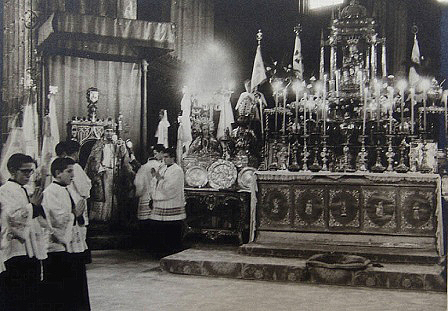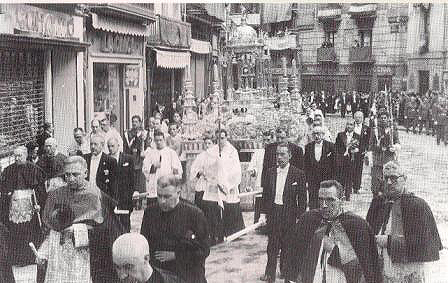The piece of the month of May 2012
THE USES OF THE PAVILION OF THE CATHEDRAL OF PAMPLONA AND THE EUCHARISTIC-MARIAN ALTAR
Alejandro Aranda Ruiz
The Council of Trent (1545-1563) had a special repercussion in the field of the arts by endorsing St. Gregory the Great's affirmation of "wanting to show the invisible by means of the visible". Thus, the art of the Counter-Reformation contributed to reinforce and spread all those truths of faith promulgated by the Council and denied by the Reformation, such as the cult of the Eucharist and the Virgin.
This fact would have its expression in the Pamplona cathedral during the pontificate of Antonio Zapata y Mendoza who occupied the mitre of San Fermín between 1596 and 1600. However, it is necessary to point out that already in times previous to Zapata and Trento, at the beginning of the XVI century, there was a desire to enlarge the cathedral cult and to provide the Pamplona cathedral with the necessary effects to such an object. On April 5, 1501, Pope Alexander VII granted a bull that intended that the cathedral be "preserved as it should be, and provided with chalices, books, patens, vestments and other ecclesiastical ornaments". To this end, the pontiff granted numerous indulgences on the occasion of the feast of the Assumption. Thus, the intervention of Antonio Zapata was a first milestone in the process of renovation and expansion of the liturgical vestments of the cathedral that would last until the 19th century. The bishop, seeking to promote Eucharistic and Marian worship, planned a series of artistic creations, including the construction of the main altarpiece, the Eucharistic shrine and the chapter sacristy. The designs for the altarpiece and the temple were entrusted to the Pamplona silversmith José Velázquez de Medrano in 1597. The altarpiece, of clear inspiration from the Escorial style, gave the main chapel greater dignity and enhancement and prevented the eyes of the faithful from being distracted by the view of the ambulatory. It was also a manifesto of Tridentine teachings with the presence of the Blessed Sacrament in the tabernacle, the Assumption of the Virgin, St. Peter or Calvary, in a clear allusion to the sacrificial character of the mass.
The Eucharistic shrine, of great magnitude, is a silver work of bas-renaissance style that combines architecture and sculpture. The piece responds to the typology of the monstrance of platforms or templete with precedents in Tarazona and Madrid. In spite of the fact that the monstrance of platforms was not very widespread at that time, this typology was chosen because it had to house an already existing monstrance. In addition, the templete provided greater visibility to the sacred form and created a kind of canopy of respect. The templete has a central plan covered by a hemispherical dome supported by pendentives and columns. The iconography, with themes from the Old and New Testament, makes continuous allusions to the Eucharist. However, the enlargement of the central opening to be able to introduce the image of Santa María la Real was not carried out in the 18th century as traditionally it has been affirmed, but in the 17th century. Already in the time of Juan Queipo del Llano, bishop of Pamplona between 1639 and 1647, there is evidence that the Virgin was placed in the shrine. In fact, it was during his stay in Pamplona when the title of Virgen del Sagrario was first recorded. For the feast of the Assumption, "at eight o'clock and average , a premium and mass is said by Mr. Queipo [...] on the altar where the holy image is [...] for vespers, the holy image is placed on the throne of the feast of Corpus Christi". Thus, the reform had to be made in the first half of the century. Likewise, as Jesús Criado Mainar points out, the templete never formed part of the altarpiece as an expositor or tabernacle.

Opening of the Marian Year, January 1, 1946
Regarding its use and function, the templete served to house the monstrance on the feast and octave of Corpus Christi and, since the 17th century, the image of Santa María la Real on the solemnity of the Assumption and during its octave. For these two festivities, don Juan Ollo relates, the throne or templete was placed crowning a grandiose portable altar erected on a square base endowed with a frontal with yellow statuettes and a tiered silver pyramid that ended in the templete that sheltered the monstrance or the image of the Virgin. This impressive altar, which could be included in the so-called altars of apparatus, was located in the center of the presbytery adorned "as magnificently as possible with vases and many candlesticks with candles". In an inventory of 1771, "a silver tier with its frontal of the same to form the altar in the middle or plane of the main chapel in the two octaves of Corpus Christi and Assumption [...] the large throne also of silver that is placed at the top of this altar" is recorded.
However, it should be noted that for Corpus Christi the pavilion was used in two ways. In the first place, for the procession it was installed in a float of which the Relations of the Corpus Christi of 1609 and 1610 speak. The Relación of 1609 indicates that the templete with the monstrance "was founded on a table like an altar on a cart" pulled by three men. However, at least since the second half of the XVIII century, the templete and the carriage were no longer used for the procession and the monstrance was carried on "some platforms covered in silver" mentioned in the inventory of 1771. In fact, in the Corpus Christi of 1759 it is recorded that "the Lord was taken on the platforms" but as the procession started to rain "the priests who carried the platforms returned the Lord to the throne". Thus, it seems that even then the shrine was used only to expose the Blessed Sacrament on the pyramidal altar. However, since 1881, the shrine was not installed on the pyramidal altar until after the procession, when "the carpenters removed the platforms from the portable altar and placed the throne with the large Monstrance, in whose form the whole Octave is". In other words, until the Corpus Christi procession, the monstrance remained on the portable altar with the simple platforms that could be "easily separated from the altar for the procession, by means of a simple rotating device". In 1946 the pyramidal altar was no longer used, but between 1950 and 1978 the small shrine was again taken out in procession on a float made from the chassis of an Episcopal horse-drawn carriage and bordered by silver bands left over from the altar.
For the feast of the Assumption, the shape of the altar was the same as for Corpus Christi, with the only exception that the Virgin was housed in the shrine. The altar was installed for the first vespers of the Assumption but with the image "as to take it in procession", that is to say, on the aforementioned silver-lined platforms. After the procession and the mass, for the second vespers, which were celebrated at three o'clock, the Holy Image was "placed on the throne of the feast of Corpus Christi". In this way the image remained during all the infra-octave days until the procession of the octave when the image was again placed on its platform "for the prebendary lords who carry Our Lady on their shoulders".
The appearance of the altar remained without substantial changes until 1908 when, thanks to a donation made by Micaela Azpíroz, Canon Nicanor Hernán acquired numerous elements that transformed the altar: a carpet, a silver frontal "de Meneses", silver plates for the sides of the altar, moldings for the tier, large candlesticks and vases and two magnificent candelabras of twenty-one arms with two matching pilasters, all of which cost two thousand pesetas. The objects were premiered on June 18, 1908, the day of Corpus Christi when there was no procession due to rain. Finally, it should be noted that the altar was also installed for extraordinary events. Due to the brevity of these notes only two examples can be cited. The solemn celebration at the beginning of the 20th century or the opening of the Marian Year of 1946, ceremony of which the only known photographs of this altar are preserved.

Corpus Christi Procession in Pamplona. 1964
SOURCES AND bibliography
-file Catedral de Pamplona. Codex 162. guide practical theoretical of the Ceremonies of the Holy Church Cathedral of Pamplona in the main festivities; Box 1324. Rubrics. Instructions and chapter agreements on ceremonies of this Holy Church, year 1820; Box 3017. Book 48, Notum 2º; Notes on the Cathedral of Pamplona by D. Juan Ollo; Box 1187. Sacristy and major work. Inventory of the jewels and ornaments of the Holy Church. Year 1771.
-ARIGITA Y LASA, M., La Asunción de la Santísima Virgen y su culto en Navarra, Madrid, Establecimiento Tipográfico de Fortanet, 1910 and GARCÍA GAÍNZA, M. C., "Actuaciones de un Obispo Postridentino en la Catedral de Pamplona", Lecturas de Historia del Arte, Vitoria, Ephialte 3, 1992, pp. 110-124.
